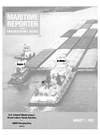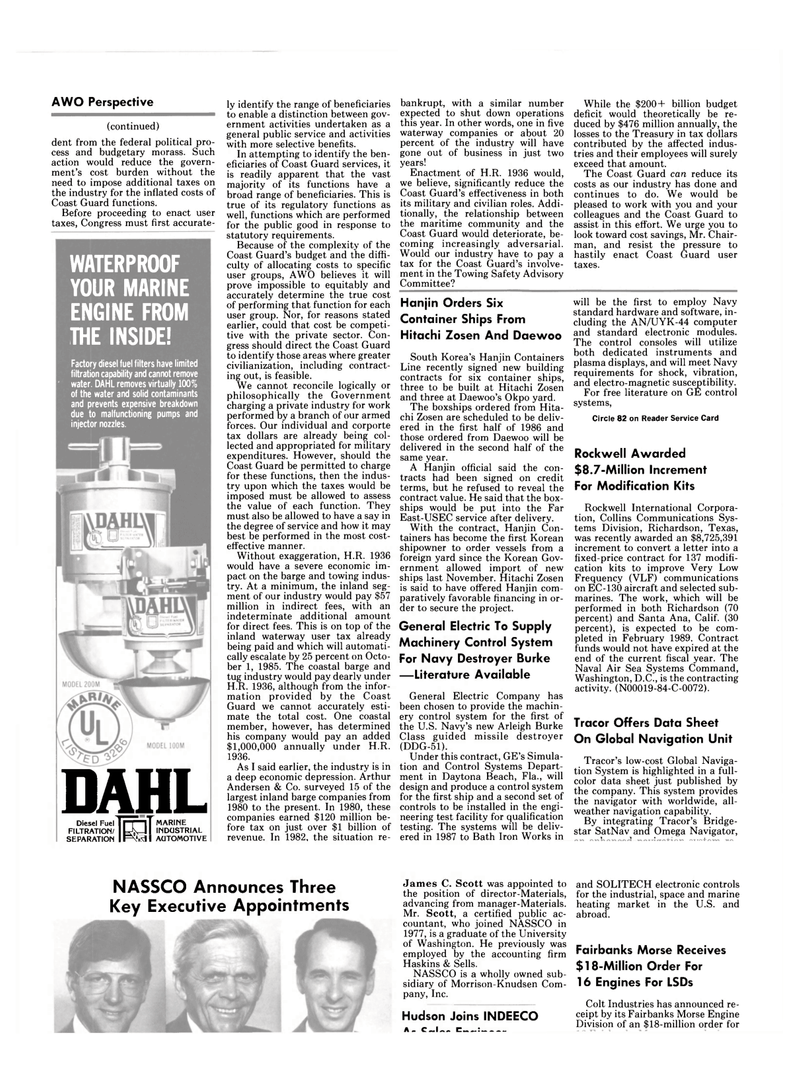
Page 10: of Maritime Reporter Magazine (August 1985)
Read this page in Pdf, Flash or Html5 edition of August 1985 Maritime Reporter Magazine
AWO Perspective (continued) dent from the federal political pro- cess and budgetary morass. Such action would reduce the govern- ment's cost burden without the need to impose additional taxes on the industry for the inflated costs of
Coast Guard functions.
Before proceeding to enact user taxes, Congress must first accurate-
WATERPROOF
YOUR MARINE
ENGINE FROM
THE INSIDE!
Factory diesel fuel filters have limited filtration capability and cannot remove water. DAHL removes virtually 100% of the water and solid contaminants and prevents expensive breakdown due to malfunctioning pumps and injector nozzles.
DAHL
Diesel FuelT^^nT MARINE
FILTRATION/ I ^vJ I INDUSTRIAL
SEPARATION I F\'hx1 I AUTOMOTIVE ly identify the range of beneficiaries to enable a distinction between gov- ernment activities undertaken as a general public service and activities with more selective benefits.
In attempting to identify the ben- eficiaries of Coast Guard services, it is readily apparent that the vast majority of its functions have a broad range of beneficiaries. This is true of its regulatory functions as well, functions which are performed for the public good in response to statutory requirements.
Because of the complexity of the
Coast Guard's budget and the diffi- culty of allocating costs to specific user groups, AWO believes it will prove impossible to equitably and accurately determine the true cost of performing that function for each user group. Nor, for reasons stated earlier, could that cost be competi- tive with the private sector. Con- gress should direct the Coast Guard to identify those areas where greater civilianization, including contract- ing out, is feasible.
We cannot reconcile logically or philosophically the Government charging a private industry for work performed by a branch of our armed forces. Our individual and corporte tax dollars are already being col- lected and appropriated for military expenditures. However, should the
Coast Guard be permitted to charge for these functions, then the indus- try upon which the taxes would be imposed must be allowed to assess the value of each function. They must also be allowed to have a say in the degree of service and how it may best be performed in the most cost- effective manner.
Without exaggeration, H.R. 1936 would have a severe economic im- pact on the barge and towing indus- try. At a minimum, the inland seg- ment of our industry would pay $57 million in indirect fees, with an indeterminate additional amount for direct fees. This is on top of the inland waterway user tax already being paid and which will automati- cally escalate by 25 percent on Octo- ber 1, 1985. The coastal barge and tug industry would pay dearly under
H.R. 1936, although from the infor- mation provided by the Coast
Guard we cannot accurately esti- mate the total cost. One coastal member, however, has determined his company would pay an added $1,000,000 annually under H.R. 1936.
As I said earlier, the industry is in a deep economic depression. Arthur
Andersen & Co. surveyed 15 of the largest inland barge companies from 1980 to the present. In 1980, these companies earned $120 million be- fore tax on just over $1 billion of revenue. In 1982, the situation re- bankrupt, with a similar number expected to shut down operations this year. In other words, one in five waterway companies or about 20 percent of the industry will have gone out of business in just two years!
Enactment of H.R. 1936 would, we believe, significantly reduce the
Coast Guard's effectiveness in both its military and civilian roles. Addi- tionally, the relationship between the maritime community and the
Coast Guard would deteriorate, be- coming increasingly adversarial.
Would our industry have to pay a tax for the Coast Guard's involve- ment in the Towing Safety Advisory
Committee?
Hanjin Orders Six
Container Ships From
Hitachi Zosen And Daewoo
South Korea's Hanjin Containers
Line recently signed new building contracts for six container ships, three to be built at Hitachi Zosen and three at Daewoo's Okpo yard.
The boxships ordered from Hita- chi Zosen are scheduled to be deliv- ered in the first half of 1986 and those ordered from Daewoo will be delivered in the second half of the same year.
A Hanjin official said the con- tracts had been signed on credit terms, but he refused to reveal the contract value. He said that the box- ships would be put into the Far
East-USEC service after delivery.
With the contract, Hanjin Con- tainers has become the first Korean shipowner to order vessels from a foreign yard since the Korean Gov- ernment allowed import of new ships last November. Hitachi Zosen is said to have offered Hanjin com- paratively favorable financing in or- der to secure the project.
General Electric To Supply
Machinery Control System
For Navy Destroyer Burke —Literature Available
General Electric Company has been chosen to provide the machin- ery control system for the first of the U.S. Navy's new Arleigh Burke
Class guided missile destroyer (DDG-51).
Under this contract, GE's Simula- tion and Control Systems Depart- ment in Daytona Beach, Fla., will design and produce a control system for the first ship and a second set of controls to be installed in the engi- neering test facility for qualification testing. The systems will be deliv- ered in 1987 to Bath Iron Works in
While the $200+ billion budget deficit would theoretically be re- duced by $476 million annually, the losses to the Treasury in tax dollars contributed by the affected indus- tries and their employees will surely exceed that amount.
The Coast Guard can reduce its costs as our industry has done and continues to do. We would be pleased to work with you and your colleagues and the Coast Guard to assist in this effort. We urge you to look toward cost savings, Mr. Chair- man, and resist the pressure to hastily enact Coast Guard user taxes. will be the first to employ Navy standard hardware and software, in- cluding the AN/UYK-44 computer and standard electronic modules.
The control consoles will utilize both dedicated instruments and plasma displays, and will meet Navy requirements for shock, vibration, and electro-magnetic susceptibility.
For free literature on GE control systems,
Circle 82 on Reader Service Card
Rockwell Awarded $8.7-Million Increment
For Modification Kits
Rockwell International Corpora- tion, Collins Communications Sys- tems Division, Richardson, Texas, was recently awarded an $8,725,391 increment to convert a letter into a fixed-price contract for 137 modifi- cation kits to improve Very Low
Frequency (VLF) communications on EC-130 aircraft and selected sub- marines. The work, which will be performed in both Richardson (70 percent) and Santa Ana, Calif. (30 percent), is expected to be com- pleted in February 1989. Contract funds would not have expired at the end of the current fiscal year. The
Naval Air Sea Systems Command,
Washington, D.C., is the contracting activity. (N00019-84-C-0072).
Tracor Offers Data Sheet
On Global Navigation Unit
Tracor's low-cost Global Naviga- tion System is highlighted in a full- color data sheet just published by the company. This system provides the navigator with worldwide, all- weather navigation capability.
By integrating Tracor's Bridge- star SatNav and Omega Navigator, u i : — +„„,
James C. Scott was appointed to the position of director-Materials, advancing from manager-Materials.
Mr. Scott, a certified public ac- countant, who joined NASSCO in 1977, is a graduate of the University of Washington. He previously was employed by the accounting firm
Haskins & Sells.
NASSCO is a wholly owned sub- sidiary of Morrison-Knudsen Com- pany, Inc.
Hudson Joins INDEECO
A _ e_l c : and SOLITECH electronic controls for the industrial, space and marine heating market in the U.S. and abroad.
Fairbanks Morse Receives $1 8-Million Order For 16 Engines For LSDs
Colt Industries has announced re- ceipt by its Fairbanks Morse Engine
Division of an $18-million order for
NASSCO Announces Three
Key Executive Appointments

 9
9

 11
11
